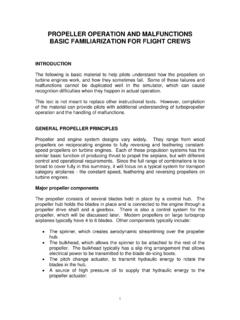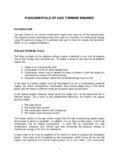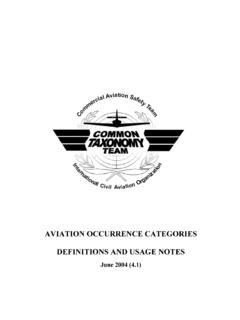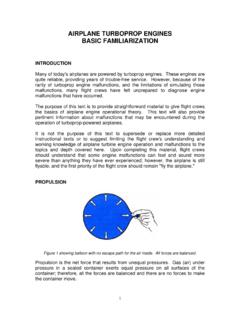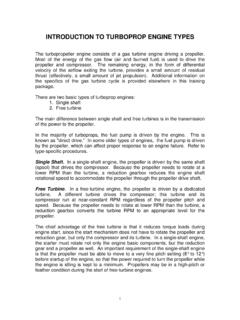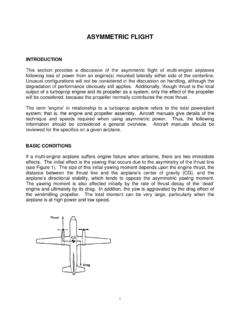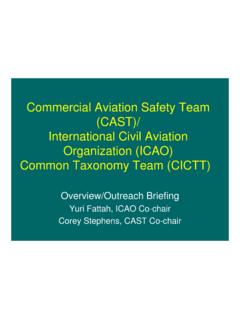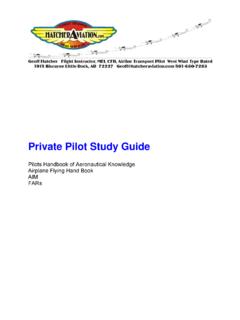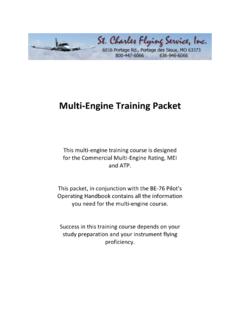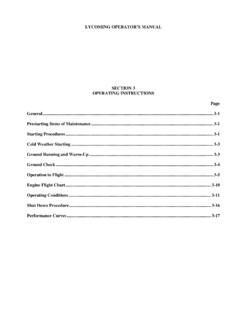Transcription of PROPELLER OPERATION AND MALFUNCTIONS BASIC …
1 1 PROPELLER OPERATION AND MALFUNCTIONS BASIC FAMILIARIZATION FOR FLIGHT CREWS INTRODUCTION The following is BASIC material to help pilots understand how the propellers on turbine engines work, and how they sometimes fail. Some of these failures and MALFUNCTIONS cannot be duplicated well in the simulator, which can cause recognition difficulties when they happen in actual OPERATION . This text is not meant to replace other instructional texts. However, completion of the material can provide pilots with additional understanding of turbopropeller OPERATION and the handling of MALFUNCTIONS .
2 GENERAL PROPELLER PRINCIPLES PROPELLER and engine system designs vary widely. They range from wood propellers on reciprocating engines to fully reversing and feathering constant-speed propellers on turbine engines. Each of these propulsion systems has the similar BASIC function of producing thrust to propel the airplane, but with different control and operational requirements. Since the full range of combinations is too broad to cover fully in this summary, it will focus on a typical system for transport category airplanes - the constant speed, feathering and reversing propellers on turbine engines.
3 Major PROPELLER components The PROPELLER consists of several blades held in place by a central hub. The PROPELLER hub holds the blades in place and is connected to the engine through a PROPELLER drive shaft and a gearbox. There is also a control system for the PROPELLER , which will be discussed later. Modern propellers on large turboprop airplanes typically have 4 to 6 blades. Other components typically include: The spinner, which creates aerodynamic streamlining over the PROPELLER hub. The bulkhead, which allows the spinner to be attached to the rest of the PROPELLER .
4 The bulkhead typically has a slip ring arrangement that allows electrical power to be transmitted to the blade de-icing boots. The pitch change actuator, to transmit hydraulic energy to rotate the blades in the hub. A source of high pressure oil to supply that hydraulic energy to the PROPELLER actuator. 2 The primary control, also called the governor, for controlling PROPELLER speed and blade pitch. The overspeed governor, which serves as a backup if the primary control MALFUNCTIONS . Figure 1 Major PROPELLER Components blade pitch The PROPELLER blade pitch, also more simply called the PROPELLER pitch, is the angle that the blade presents to the plane of rotation of the PROPELLER .
5 The blade pitch known as feather describes the pitch that results in no or slow rotation of the PROPELLER at a specific flight condition (typically, cruise) with the engine shut down. Due to the twist of the blade , this angle is typically slightly less than 90 degrees. Basically, feather leaves the PROPELLER blades edge-on to the direction of travel. Flat pitch refers to the pitch that results in minimum torque with the engine operating while on the ground. Typically, flat pitch is about 0 degrees. The blades present an essentially flat face to the direction of travel.
6 Angles below flat pitch are considered reverse pitch. Pitch anglePlane of RotationDirectionof TravelFeatherFlat Pitch Figure 2 blade Pitch 3 blade twist PROPELLER blades need to be twisted to optimize the aerodynamic performance of the specific blade design with the angle of attack to the air as they rotate. The angle of the air approaching a blade is a combination of the airplane s forward speed and the PROPELLER s rotational speed. The airplane forward speed is constant along the blade , but the rotational speed increases from the blade root to the blade tip (the tip has to travel farther for each rotation).
7 This means that the PROPELLER blade needs to be twisted to get the optimum amount of lift along the full length of the blade . Thrust Propellers produce thrust using the same principle as airplane wings do to produce lift. If you look at a section of a PROPELLER blade , you will notice that it looks like a wing. The air approaches the blade section (airfoil) at an angle of attack that causes a pressure change over the airfoil, producing lift. This lift produces a force to propel the airplane in the direction of flight. The PROPELLER produces the majority of the thrust for the airplane, but the engine also provides a small amount.
8 The PROPELLER accelerates the air into the engine inlet, and the engine itself further accelerates the air out the exhaust. This force of the exhaust air out the back of the engine results in an equal and opposite force that pushes the engine (and thus, the airplane) forward, adding to the thrust. Constant speed PROPELLER A constant speed PROPELLER is a PROPELLER with a control system that maintains a constant PROPELLER rotational speed (RPM) setting at any flight condition. To maintain constant PROPELLER RPM, you must adjust the pitch of the PROPELLER blades as you change airspeed and/or engine power.
9 The pitch is adjusted by rotating the whole blade on a bearing in the hub using an actuator that is linked to the control system. When you change the pitch, you change the "bite" that the blades make with the wind. This, in turn, increases or decreases the aerodynamic load on the PROPELLER . The advantages of a modern turboprop constant speed PROPELLER are: better performance over a wider range of flight conditions, the ability to produce reverse thrust during landing rollout and ground handling, and the ability to minimize drag on the aircraft by feathering the PROPELLER in the event of an engine shutdown.
10 Efficiency and speed control. Since all turbine engines are most efficient within specific RPM ranges, it is desirable to have a PROPELLER with the ability to change thrust while maintaining the most efficient engine RPM possible. In a PROPELLER , this is done by changing the PROPELLER blade pitch, which increases or decreases the load as needed to maintain a constant RPM. The ability of the 4 PROPELLER to change pitch allows both the engine and the PROPELLER to spend most of their time operating in their most efficient range. Reverse thrust. Pitch angle can be changed to actually produce reverse thrust.
